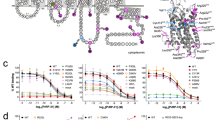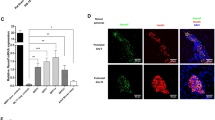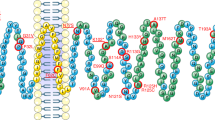Abstract
Objective:
The Gnas transcription unit located within an imprinting region encodes several proteins, including the G-protein α-subunit, Gsα, its isoform XLαs and their variant truncated neural forms GsαN1 and XLN1. Gsα and GsαN1 are expressed predominantly from the maternally derived allele in some tissues, whereas XLαs and XLN1 are expressed exclusively from the paternally derived allele. The relative contribution of full-length Gsα and XLαs, and truncated forms GsαN1 and XLN1 to phenotype is unknown. The edematous-small point mutation (Oed-Sml) in exon 6 of Gnas lies downstream of GsαN1 and XLN1, but affects full-length Gsα and XLαs, allowing us to address the role of full-length Gsα and XLαs. The aim of this study was therefore to determine the metabolic phenotypes of Oed and Sml mice, and to correlate phenotypes with affected transcripts.
Methods:
Mice were fed standard or high-fat diets and weighed regularly. Fat mass was determined by DEXA analysis. Indirect calorimetry was used to measure metabolic rate. Glucose was measured in tolerance tests and biochemical parameters in fasted plasma samples. Histological analysis of fat and liver was carried out post mortem.
Results:
Oed mice are obese on either diet and have a reduced metabolic rate. Sml mice are lean and are resistant to a high-fat diet and have an increased metabolic rate.
Conclusion:
Adult Oed and Sml mice have opposite metabolic phenotypes. On maternal inheritance, the obese Oed phenotype can be attributed to non-functional full-length Gsα. In contrast, on paternal inheritance, Sml mice were small and resistant to the development of obesity on a high-fat diet, effects that can be attributed to mutant XLαs. Thus, the neural isoforms, GsαN1 and XLN1, do not appear to play a role in these metabolic phenotypes.
This is a preview of subscription content, access via your institution
Access options
Subscribe to this journal
Receive 12 print issues and online access
$259.00 per year
only $21.58 per issue
Buy this article
- Purchase on Springer Link
- Instant access to full article PDF
Prices may be subject to local taxes which are calculated during checkout







Similar content being viewed by others
References
Holmes R, Williamson C, Peters J, Denny P, Wells C . A comprehensive transcript map of the mouse Gnas imprinted complex. Genome Res 2003; 13: 1410–1415.
Plagge A, Gordon E, Dean W, Boiani R, Cinti S, Peters J et al. The imprinted signaling protein XL alpha s is required for postnatal adaptation to feeding. Nat Genet 2004; 36: 818–826.
Peters J, Holmes R, Monk D, Beechey CV, Moore GE, Williamson CM . Imprinting control within the compact Gnas locus. Cytogenet Genome Res 2006; 113: 194–201.
Weinstein LS, Yu S, Warner DR, Liu J . Endocrine manifestations of stimulatory G protein. Endocr Rev 2001; 22: 675–705.
Peters J, Wroe SF, Wells CA, Miller HJ, Bodle D, Beechey CV et al. A cluster of oppositely imprinted transcripts at the Gnas locus in the distal imprinting region of mouse chromosome 2. Proc Natl Acad Sci USA 1999; 96: 3830–3835.
Pasolli HA, Klemke M, Kehlenbach RH, Wang Y, Huttner WB . Characterization of the extra-large G protein alpha -subunit xlalpha s. I. Tissue distribution and subcellular localization. J Biol Chem 2000; 275: 33622–33632.
Klemke M, Pasolli HA, Kehlenbach RH, Offermanns S, Schultz G, Huttner WB . Characterization of the extra-large G protein alpha-subunit XLalpha s. II. Signal transduction properties. J Biol Chem 2000; 275: 33633–33640.
Chen M, Gavrilova O, Liu J, Xie T, Deng C, Nguyen AT et al. Alternative Gnas gene products have opposite effects on glucose and lipid metabolism. Proc Natl Acad Sci USA 2005; 102: 7386–7391.
Xie T, Plagge A, Gavrilova O, Pack S, Jou W, Lai EW et al. The alternative stimulatory G protein alpha-subunit XLalphas is a critical regulator of energy and glucose metabolism and sympathetic nerve activity in adult mice. J Biol Chem 2006; 281: 18989–18999.
Klemke M, Kehlenbach RH, Huttner WB . Two overlapping reading frames in a single exon encode interacting proteins—a novel way of gene usage. EMBO J 2001; 20: 3849–3860.
Yu S, Castle A, Chen M, Lee R, Takeda K, Weinstein LS . Increased insulin sensitivity in Gsalpha knockout mice. J Biol Chem 2001; 276: 19994–19998.
Yu S, Gavrilova O, Chen H, Lee R, Liu J, Pacak K et al. Paternal versus maternal transmission of a stimulatory G-protein {alpha} subunit knockout produces opposite effects on energy metabolism. J Clin Invest 2000; 105: 615–623.
Yu S, Yu D, Lee E, Eckhaus M, Lee R, Corria Z et al. Variable and tissue-specific hormone resistance in heterotrimeric Gs protein alpha-subunit (Gsalpha) knockout mice is due to tissue-specific imprinting of the Gsalpha gene. Proc Natl Acad Sci USA 1998; 95: 8715–8720.
Cattanach BM, Peters J, Ball S, Rasberry C . Two imprinted gene mutations: three phenotypes. Hum Mol Genet 2000; 9: 2263–2273.
Skinner JA, Cattanach BM, Peters J . The imprinted oedematous-small mutation on mouse chromosome 2 identifies new roles for Gnas and Gnasxl in development. Genomics 2002; 80: 373–375.
Williamson CM, Ball ST, Nottingham WT, Skinner JA, Plagge A, Turner MD et al. A cis-acting control region is required exclusively for the tissue-specific imprinting of Gnas. Nat Genet 2004; 36: 894–899.
Schmidt-Nielsen K . Energy metabolism, metabolic rate and body size. Animal Physiology 1990. 4th edn. Cambridge University Press: Cambridge, UK, pp 192–201.
Chen M, Gavrilova O, Liu J, Xie T, Deng C, Nguyen AT et al. Alternative Gnas gene products have opposite effects on glucose and lipid metabolism. Proc Natl Acad Sci USA 2005; 102: 7386–7391.
Chen M, Gavrilova O, Zhao WQ, Nguyen A, Lorenzo J, Shen L et al. Increased glucose tolerance and reduced adiposity in the absence of fasting hypoglycemia in mice with liver-specific Gs alpha deficiency. J Clin Invest 2005; 115: 3217–3227.
Long DN, McGuire S, Levine MA, Weinstein LS, Germain-Lee EL . Body mass index differences in pseudohypoparathyroidism type1a versus pseudopseudohypoparathyroidism may implicate paternal imprinting of Galpha(s) in the development of human obesity. J Clin Endocrinol Metab 2007; 92: 1073–1079.
Frontera M, Dickins B, Plagge A, Kelsey G . Imprinted genes, postnatal adaptations and enduring effects on energy homeostasis. Adv Exp Med Biol 2008; 626: 41–61.
Acknowledgements
The authors thank the Medical Research Council and EC FP6 (Contract LSHM-CT-2003-503041) for support for this work. We also thank Swedish Research Council (No 09894). We thank the staff of the Mary Lyon Centre for their technical support; we also thank the Clinical Chemistry Department for all their help. We thank Mr Colin Beechey for providing Figure 1. QMA is a Medical Research Council-funded Clinical Research Fellow and Imperial College BRC Investigator.
Author information
Authors and Affiliations
Corresponding author
Rights and permissions
About this article
Cite this article
Kelly, M., Moir, L., Jones, L. et al. A missense mutation in the non-neural G-protein α-subunit isoforms modulates susceptibility to obesity. Int J Obes 33, 507–518 (2009). https://doi.org/10.1038/ijo.2009.30
Received:
Revised:
Accepted:
Published:
Issue Date:
DOI: https://doi.org/10.1038/ijo.2009.30
Keywords
This article is cited by
-
Imprinted genes and the manipulation of parenting in mammals
Nature Reviews Genetics (2023)
-
The Distinct Role of the Extra-Large G Protein ɑ-Subunit XLɑs
Calcified Tissue International (2020)
-
Genomic imprinting and its effects on postnatal growth and adult metabolism
Cellular and Molecular Life Sciences (2019)
-
The role of genomic imprinting in biology and disease: an expanding view
Nature Reviews Genetics (2014)
-
Maternal inheritance of the Gnas cluster mutation Ex1A-T affects size, implicating NESP55 in growth
Mammalian Genome (2013)



